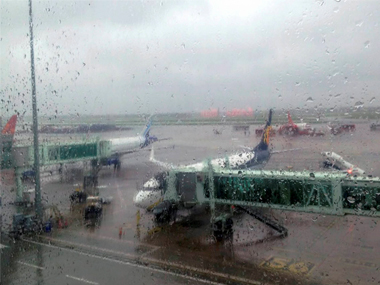Heavy rains along with squally winds lashed Kolkata and southern districts of West Bengal on Monday affecting flight and train movements, waterlogging major thoroughfares and bringing traffic to a halt. The rains, which began on Sunday night, continued on Monday, throwing normal life off gear on the first working day of the week. Affected areas Trees were uprooted and roads flooded in areas like New Alipur, Narkeldanga, Gariahat and Jadavpur. Slow traffic movements were reported from some parts of the city including the EM Bypass, NSC Bose Road and Commissariat Road, reported NDTV. [caption id=“attachment_4125573” align=“alignleft” width=“380”] Aircrafts are seen on the tarmac amidst heavy rain in Kolkata on Monday. PTI[/caption] Many schools, which re-opened after Durga Puja vacations, were compelled to declare a holiday due to the unpleasant weather. The heavy rains disrupted services at the city’s Netaji Subhas Chandra Bose International Airport as 13 flights were cancelled and 82 rescheduled, a senior Airports Authority of India (AAI) official told PTI. Eight flights scheduled to depart from Kolkata and five flights which were slated for arrival had been cancelled till 3.30 pm, the senior official said. At least 47 incoming flights and 35 outgoing flights were rescheduled, the official said. At least 23 domestic flights were diverted, according to ANI. The situation will change only if the weather conditions improve, he said. The continuous rain, which started late last night, not only affected flights but also resulted in waterlogging in and around the airport. Arrival of as many as 47 flights and departure of about 35 flights was rescheduled and many flights were delayed, an official said. According to railway officials, the suburban and long distance train services of both Eastern and South Eastern Railways were affected slightly in the morning due to the rains. Rains were triggered by deep depression The rain and wind uprooted trees in many areas of northern and southern parts of the city. The weather department said the inclement weather was triggered by a deep depression. “A deep depression has formed over Gangetic West Bengal and adjoining north Bay of Bengal,” an official of the Regional Meteorological Centre said. “The system is very likely to move slowly west-northwestwards initially during next 24 hours and move northwards thereafter,” tweeted the IMD in the afternoon. The local weather office forecast more rains in the next 48 hours. “Under the influence of deep depression over Gangetic West Bengal, heavy to very heavy (7-20 cm) rainfall at a few places with isolated extremely heavy (over 20 cm) fall is likely over Gangetic West Bengal during next 48 hours,” it said. Squally winds speed reaching 45-55 kilometre per hour and gusting to 65 kilometre per hour would prevail along and off the coast. “Strong wind speed reaching 30-40 kilometre per hour gusting to 50 kilometre per hour would prevail over interior parts of Gangetic West Bengal during next 48 hours,” it said. Fishermen have been advised not to venture into the sea during this period. Lack of proper drainage cause of flood-like situations A
study conducted by Presidency University, Kolkata said that the city was swamped after the over-night heavy rainfall because it lacked proper drainage system. The study stated that the reason behind the city’s dismal drainage and sewerage system was the unscientific land use system in the city. As more and more open spaces were replaced with high rise buildings, the risk of submergence increased as well, leading to a waterlogging situation even after a downpour for a relatively shorter period of time. Situation in Kolkata reminiscent of Mumbai rains What do megalopolises like Mumbai and Kolkata have in common? Terrible town planning, it turns out. On 29 August, torrential rain accompanied by strong winds pummeled Mumbai,
disrupting rail, road and air services , uprooting trees, swamping homes, and bringing the megapolis and its satellite towns to their knees. As with West Bengal, although a heavy downpour was predicted by the IMD, there was little to no preparedness. Lakhs of people were stranded across the city and five people lost their lives, including
Dr Deepak Amrapurkar whose body was found washed ashore Worli 48 hours after he fell into an open manhole in a flooded Lower Parel street.
Experts also attributed the waterlogging to faulty town planning in Mumbai. Milind Mhaske, project director at the Praja Foundation, explained that the ever-increasing density of people living in the city put a strain on its infrastructure. As developing authorities grant more building permissions, more and more people find places to live but they use the same public facilities. This results in the drainage and water management systems being thrown out of gear when faced with the monsoon. With inputs from agencies
Many schools in Kolkata, which re-opened after Durga Puja vacations, were compelled to declare a holiday due to the unpleasant weather.
Advertisement
End of Article


)




